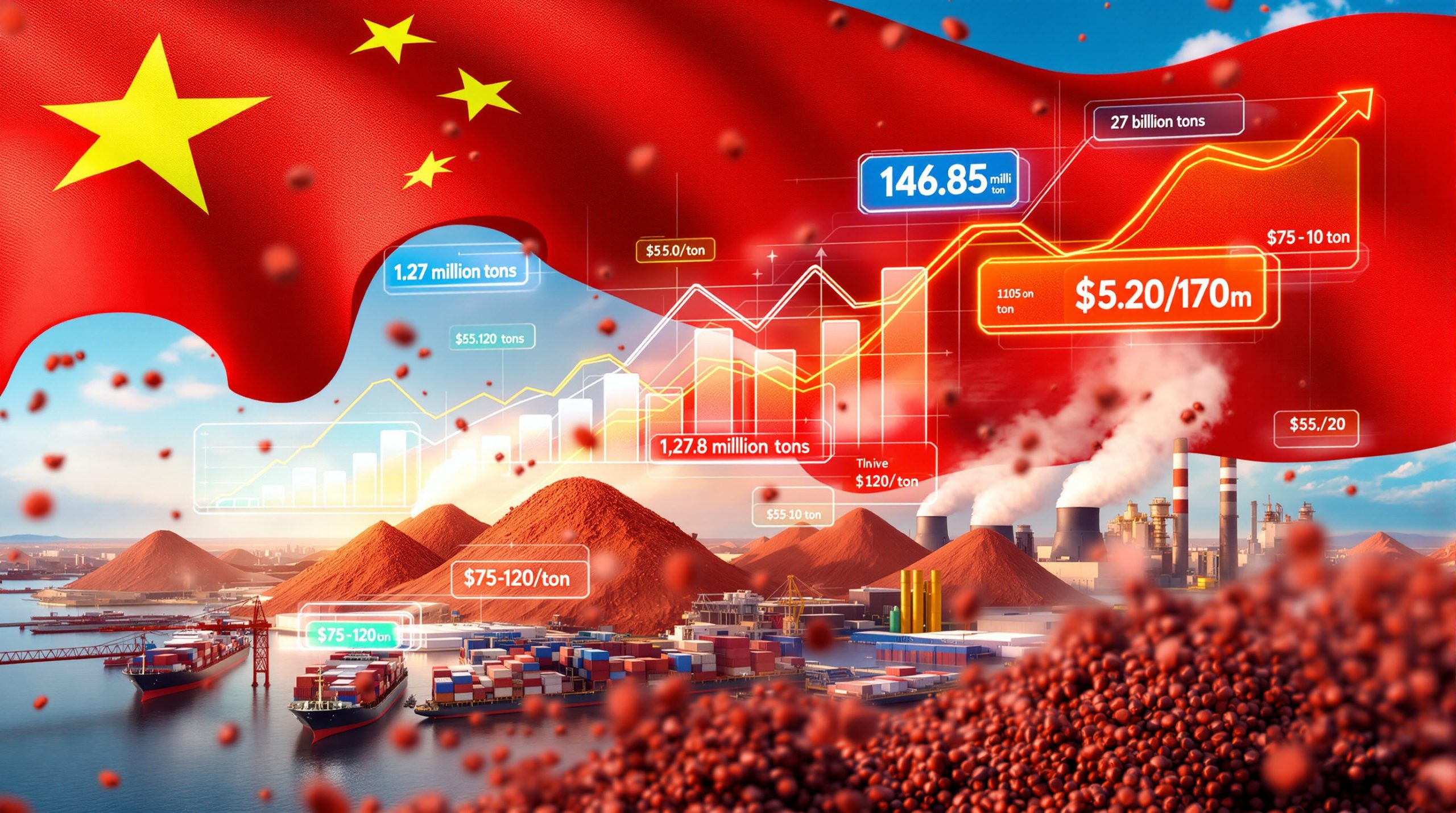Understanding the Structural Forces Behind China's Ore Import Patterns
Global commodity markets often operate according to predictable supply-demand mechanics, yet China's iron-ore demand in China patterns in 2025 present a compelling case study in market complexity. Despite facing significant headwinds across traditional steel-consuming sectors, particularly real estate construction, Chinese mills continue demonstrating robust appetite for high-grade imported ore materials. This apparent contradiction reflects deeper structural transformations within the world's largest steel-producing economy, where operational flexibility has become paramount to maintaining profitability amid volatile market conditions.
The persistence of elevated import volumes during a period of domestic demand contraction suggests that quality differentials, supply chain optimization, and strategic inventory management now outweigh simple volume-based purchasing decisions. Understanding these dynamics requires examination of both immediate market mechanics and longer-term industrial transformation trends reshaping iron ore price trends.
What Drives China's Paradoxical Iron-Ore Import Surge Despite Steel Sector Headwinds?
Current Import Momentum Defying Market Logic
Recent trading sessions have highlighted the persistence of Chinese demand despite broader sectoral challenges. On November 19, 2025, the most-traded January iron ore contract on China's Dalian Commodity Exchange closed at 791.5 yuan ($111.32) per metric ton, representing a 0.76% intraday gain. Furthermore, the contract reached its highest level since November 3 at 797 yuan during the session, while the benchmark December contract on Singapore Exchange traded at $104.55 per ton.
This pricing momentum reflects underlying demand resilience that extends beyond simple market speculation. Chinese steel producers have fundamentally altered their raw material procurement strategies over recent years, moving away from traditional bulk purchasing toward more dynamic inventory management approaches. Consequently, this shift has created a market environment where frequent spot market activity provides greater liquidity and price discovery mechanisms.
The operational flexibility demonstrated by Chinese mills represents a sophisticated response to margin pressures that have intensified during the property sector downturn. Rather than reducing production capacity, mills have optimised their product mix to capitalise on higher-margin opportunities in manufacturing-oriented steel products, maintaining relatively stable hot metal output levels despite construction sector weakness. However, these developments coincide with price decline amid surplus conditions affecting global markets.
Steel Production Plateau vs. Demand Contraction Analysis
Chinese steel mills have adapted to challenging market conditions through strategic production adjustments that prioritise profitability over absolute volume. Industry analysis indicates that mills have been flexibly adjusting their production strategy, switching to make more flat steel when it's more profitable to do so, according to Ge Xin, deputy director at consultancy Lange Steel. This tactical approach has resulted in hot metal output remaining at relatively high levels despite broader demand pressures.
The significance of this production strategy lies in its implications for raw material consumption. Hot metal, produced in blast furnaces, serves as a key indicator of iron-ore demand intensity, while flat steel products primarily serve manufacturing sector applications rather than construction markets. In addition, this production reallocation suggests that Chinese steelmakers are successfully navigating demand shifts by targeting more resilient end-use markets.
The adoption of low-inventory strategies for raw materials over the past three years has fundamentally altered purchasing patterns across the Chinese steel industry. Margin compression from falling steel prices amid a protracted property downturn has forced mills to optimise working capital management while maintaining operational flexibility. This approach has created a market dynamic where mills return to the spot market to restock cargoes more frequently, thereby improving spot liquidity and providing greater price stability during market volatility.
How Are Supply Chain Dynamics Reshaping China's Iron-Ore Strategy?
Domestic Production Constraints Creating Import Dependency
China's domestic iron-ore production continues facing significant structural challenges that reinforce import dependency trends. Official data reveals that domestically produced run-of-mine fell 2.9% year-over-year to 84.03 million tons in October 2025, highlighting persistent capacity constraints within the domestic mining sector.
The quality differential between domestic and imported ore materials represents a fundamental economic driver supporting continued import demand. While domestic Chinese ore typically contains 30-40% iron content, imported materials from major suppliers like Australia and Brazil average 60-65% iron concentration. Consequently, this quality premium becomes increasingly important as Chinese steel producers optimise their blast furnace operations for efficiency and environmental compliance.
Transportation and processing economics further reinforce the preference for high-grade imported materials. Despite additional shipping costs, the higher iron content of imported ore reduces the total tonnage required per unit of steel output, improving overall production efficiency and reducing waste handling requirements at mill sites. For instance, miner surge insights highlight how companies are adapting to these changing demands.
Global Supply Expansion Timeline
International iron-ore supply capacity continues expanding across multiple regions, creating competitive pressures that benefit Chinese purchasers. Australian producers have announced significant capacity additions, with projects including Rio Tinto's Western Range development, Fortescue's Iron Bridge operation, and Mineral Resources' Onslow project collectively adding approximately 20 million tons of annual capacity to global markets.
Brazilian production targets remain ambitious, with Vale targeting 325-335 million tons annual output as operational efficiency improvements and expansion projects come online. These capacity additions provide Chinese buyers with greater supply security and competitive pricing opportunities, particularly for high-grade ore specifications required for advanced steelmaking processes.
The anticipated completion of Guinea's Simandou project represents a significant new supply source expected to impact global trade flows. This development, scheduled for late 2025, may influence strategic purchasing decisions among Chinese steel producers seeking to diversify their supplier base. Furthermore, these developments occur alongside improvements in iron haulage operations across major mining regions, enhancing supply chain reliability.
What Price Dynamics Are Shaping Market Behaviour in 2025?
Current Pricing Environment and Volatility Drivers
Iron-ore pricing in 2025 reflects the complex interplay between supply expansion, demand optimisation, and inventory management strategies. Recent trading sessions demonstrate the market's sensitivity to both fundamental supply-demand factors and technical trading patterns driven by inventory levels and mill restocking cycles.
| Price Metric | November 2025 Level | Key Characteristics |
|---|---|---|
| DCE January Contract | 791.5 yuan ($111.32/ton) | 0.76% daily gain, highest since Nov 3 |
| Singapore December | $104.55/ton | 0.14% daily gain, approaching Nov 4 high |
| Session Highs | 797 yuan / $104.95 | Multi-week resistance levels |
| Price Drivers | Firm demand, lower domestic supply | Mill restocking, inventory optimisation |
Market analysts have identified several factors constraining further price appreciation, including high portside inventories and forecasts of growing supply of seaborne cargoes. These supply-side pressures provide a ceiling for price advances while fundamental demand factors continue supporting current pricing levels.
Recent Market Movements
The November 2025 price recovery reflects multiple converging factors that highlight the complexity of modern iron-ore markets. Firm demand from China combined with falling domestic supply created favourable conditions for price appreciation, while inventory management strategies among Chinese mills provided additional support for spot market activity.
The shift toward frequent spot market purchasing has created a more dynamic pricing environment where short-term supply-demand imbalances can generate significant price movements. However, this market structure provides greater price discovery efficiency but also increases volatility as mills adjust their purchasing patterns based on production requirements and margin considerations.
Trading patterns suggest that Chinese steel producers have developed sophisticated approaches to raw material procurement that balance cost optimisation with supply security. For instance, the ability to switch between product types based on profitability while maintaining stable raw material inputs demonstrates operational flexibility that supports continued iron-ore demand in China despite broader sectoral challenges.
How Is China's Steel Industry Transformation Affecting Iron-Ore Demand Patterns?
Technology Transition Impact Assessment
Chinese steelmakers are gradually implementing technology transitions that will fundamentally alter iron-ore consumption patterns over the medium term. The planned adoption of electric arc furnace (EAF) technology, targeting 15% of total production by 2025, represents a significant shift away from traditional blast furnace operations that consume primary iron-ore materials.
EAF technology utilises scrap steel as its primary input material, reducing the iron-ore intensity per ton of finished steel output. This technological transition aligns with China's environmental objectives while providing economic benefits through reduced raw material costs and improved energy efficiency. However, the current EAF adoption rate remains minimal, limiting near-term impacts on iron-ore demand.
The development of low-carbon steelmaking processes, including direct reduction methods, favours higher-grade ore specifications that can achieve the iron purity requirements for advanced steel products. Consequently, this trend supports continued demand for premium-grade imported materials while potentially reducing total tonnage requirements through improved metallurgical efficiency. Industry developments at largest iron ore mines reflect these evolving quality demands.
Inventory Management Strategy Evolution
The transformation of inventory management practices across the Chinese steel industry has created fundamental changes in iron-ore purchasing patterns. The adoption of low-inventory strategies represents a strategic response to margin pressures while providing operational flexibility during volatile market conditions.
Chinese mills have demonstrated remarkable adaptability in their production strategies, with the ability to switch to make more flat steel when it's more profitable while maintaining hot metal output at relatively high levels. Furthermore, this operational flexibility requires sophisticated raw material planning that balances just-in-time delivery with production continuity requirements.
The shift toward spot market purchasing has improved market liquidity while providing mills with greater pricing flexibility. Rather than committing to long-term contracts at fixed prices, mills can now optimise their purchasing timing based on production schedules and market conditions. This approach has acted as a buffer amid price slumps while providing access to competitive pricing during favourable market periods.
What Are the Long-Term Structural Implications for Iron-Ore Demand?
Demand Trajectory Scenarios
Long-term projections for Chinese iron-ore consumption must account for multiple variables including technological adoption rates, environmental regulations, economic growth patterns, and sectoral demand evolution. Conservative estimates suggest potential demand decline toward 800-900 million tons annually by 2035, while more optimistic scenarios envision sustained demand above 900 million tons through continued manufacturing sector growth.
| Timeframe | Conservative Scenario | Base Case Scenario | Growth Scenario |
|---|---|---|---|
| 2025-2027 | 950-980 million tons | 1.0-1.05 billion tons | 1.1+ billion tons |
| 2028-2030 | 850-900 million tons | 900-950 million tons | 1.0+ billion tons |
| 2031-2035 | 750-800 million tons | 800-850 million tons | 900+ million tons |
These projections reflect the complex interplay between declining construction sector demand and potential growth in manufacturing, infrastructure modernisation, and export-oriented steel production. The actual trajectory will depend significantly on policy decisions regarding environmental standards, urban development patterns, and industrial competitiveness priorities.
Quality Premium Evolution
The evolution toward higher-grade ore consumption reflects both technological requirements and environmental compliance objectives. Low-carbon steelmaking processes increasingly require 65%+ iron content materials, creating sustained demand for premium-grade imported ore despite potential volume reductions.
Pellet feed and processed iron-ore products are gaining market share as direct reduction processes become more prevalent. These value-added materials command significant premiums over standard ore but provide operational benefits including reduced energy consumption, lower emissions, and improved metallurgical performance.
The continued displacement of domestic Chinese ore by imported materials reflects both quality considerations and economic optimisation. Despite transportation costs, imported high-grade materials provide superior value proposition through reduced processing requirements, improved blast furnace efficiency, and enhanced product quality consistency.
How Should Stakeholders Position for China's Iron-Ore Market Evolution?
Strategic Positioning Framework
Mining Company Considerations:
-
Capacity Development Timing: Balancing current demand strength against projected long-term decline requires careful evaluation of project economics and payback periods
-
Quality Focus Strategy: Prioritising high-grade ore projects and processing capabilities to meet evolving steelmaking technology requirements
-
Geographic Diversification: Reducing China dependency through alternative market development while maintaining competitive position in the world's largest market
Steel Producer Strategy:
-
Technology Investment Planning: Coordinating EAF and direct reduction capacity development with raw material procurement strategies
-
Raw Material Optimisation: Developing ore grade mix strategies that balance cost efficiency with production flexibility requirements
-
Supply Chain Resilience: Building supplier diversification while maintaining operational continuity through volatile market periods
Investor and Trader Positioning:
-
Cycle Analysis: Distinguishing between structural demand evolution and cyclical market fluctuations for investment timing decisions
-
Risk Assessment: Evaluating geopolitical, logistical, and regulatory factors affecting supply chain stability
-
Technology Timeline Monitoring: Tracking steelmaking transformation pace to anticipate demand pattern shifts
Key Monitoring Indicators
Primary Market Signals:
-
Monthly Import Volumes: Leading indicator changes provide early insight into demand trajectory modifications
-
Port Inventory Levels: Critical signal of supply-demand balance shifts and mill restocking patterns
-
Steel Production Method Mix: EAF adoption rate tracking indicates technology transition pace
-
Government Policy Announcements: Environmental regulations and stimulus measures significantly impact demand patterns
Secondary Indicators:
-
Domestic Ore Production Trends: Capacity utilisation and grade improvement efforts affect import requirements
-
Hot Metal Output Stability: Blast furnace operations indicate iron-ore demand intensity
-
Flat Steel vs. Long Product Ratios: Production mix changes signal end-use market evolution
-
Scrap Steel Availability: Recycling capacity development affects primary ore demand requirements
The Chinese iron-ore demand in China continues demonstrating remarkable resilience despite significant structural challenges. According to recent analysis, this market paradox reflects the complex dynamics between supply optimisation and operational flexibility. Additionally, global commodities data indicates that pricing mechanisms remain highly sensitive to these evolving demand patterns. Success in this evolving environment requires sophisticated understanding of operational flexibility, quality requirements, and long-term transformation trends that will reshape global commodity trade patterns over the coming decade.
Disclaimer: This analysis contains forward-looking statements and projections based on current market conditions and available data. Actual market developments may differ materially from projections presented. Readers should conduct independent research and consult qualified professionals before making investment decisions.
Ready to Capitalise on China's Iron-Ore Market Dynamics?
Discovery Alert's proprietary Discovery IQ model delivers real-time alerts on significant ASX mineral discoveries, instantly empowering subscribers to identify actionable opportunities in iron ore and related commodities ahead of the broader market. Begin your 30-day free trial today at Discovery Alert and secure your market-leading advantage as China's import patterns continue reshaping global commodity flows.




